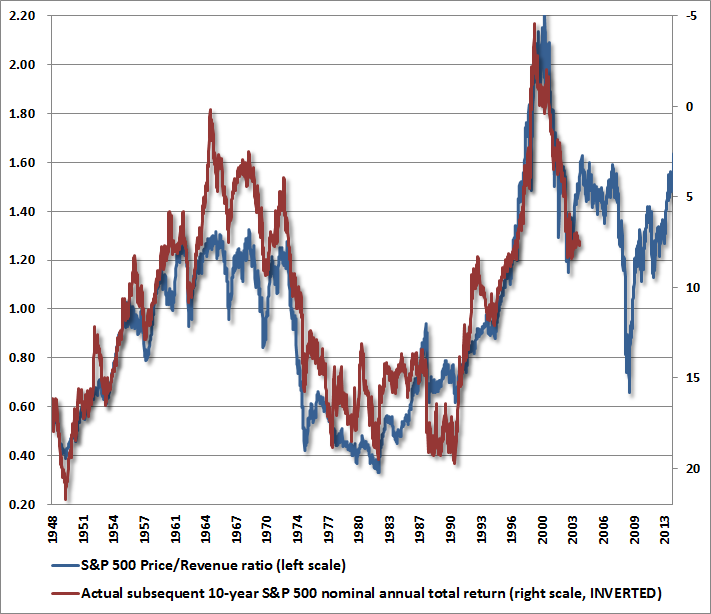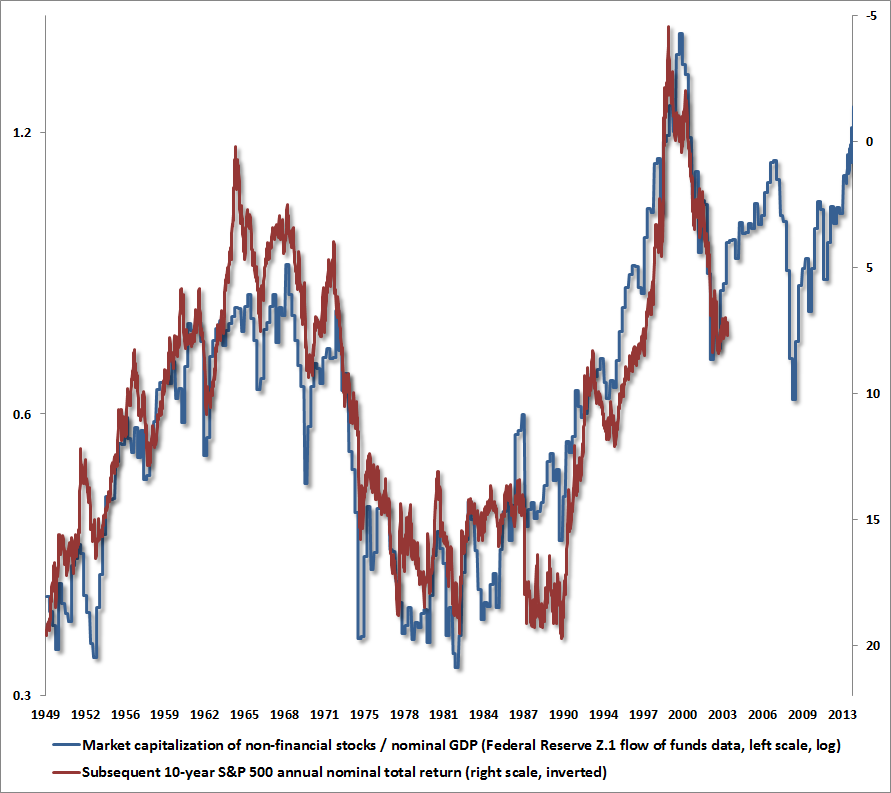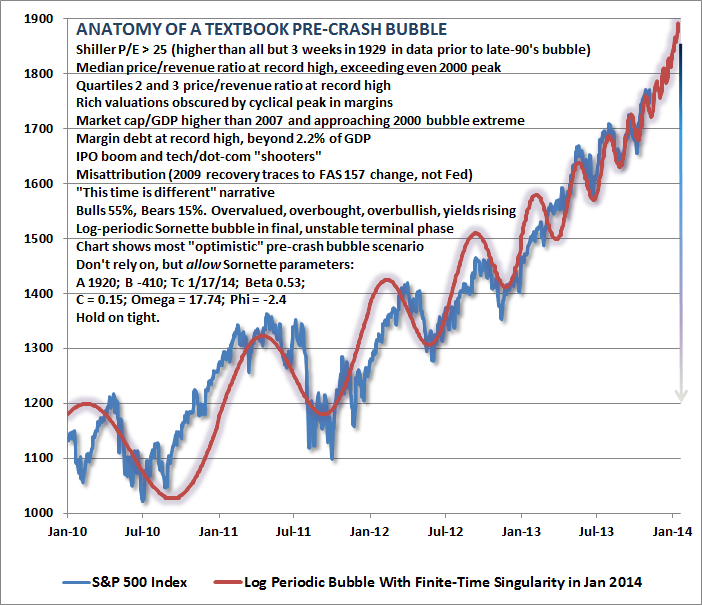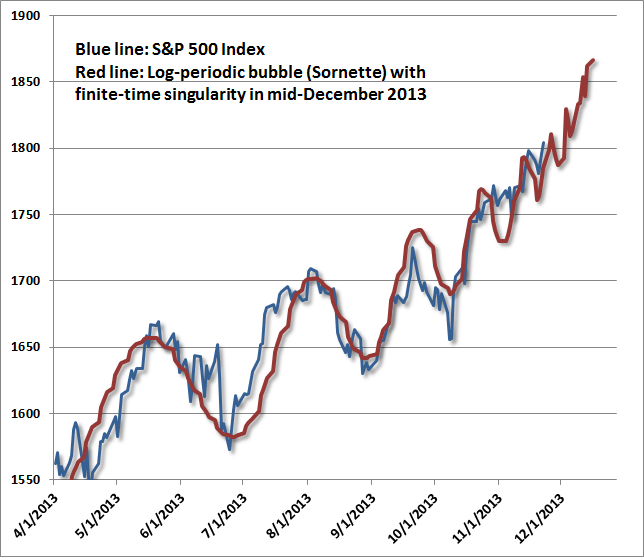The only thing that prevents us from going all in short the S&P following the revelation that Goldman’s first revealed top trade of 2014 is to go long the S&P Dec 2014 futures with a target of 2250 and a close below 1855, is that the reco is not from Tom Stolper but his colleague Noah Weisberger whose muppet wipe out record is not quite as prominent. Still, for Goldman clients to buy S&P futs, Goldman has to sell it to them, and as always – do what Goldman does, not what it says.
Recommended Top Trades for 2014
Longer-term structural views are expressed in our Top Trade recommendations. These are typically managed with a wide stop, and assessed on the basis of whether the fundamentals continue to support the medium-term investment theme.
1) Open long SP 500 Dec 14 Future and (funded out of) short AUD/USD Dec 14 Future, opened at 1986.8 on 25 Nov 2013, with a target of 2250 and a stop on a close below 1855, currently at 1986.8.
More from Goldman’s Weisberger:
1. Top Trade Recommendation #1: Long S&P short AUD for a target of +c13% and a stop loss of –c6.5%
On Friday the US equity market closed on fresh highs, with the S&P 500 climbing to 1804, amidst moderating longer dated US yields. Oil prices moderated a bit, and EM currencies continued to weaken. The Yen continued to weaken too, with last week’s move below 100 still intact. And the USD strengthened against most major crosses. In early action, Asian markets were dominated by further gains in the Nikkei and $/JPY.
Last week, we released our new 2014 economic and market forecasts and list of 2014 Top Ten market themes (see Global Viewpoint 13/05, Nov 20, 2013). And beginning with today’s Global Market Daily, we will be revealing our initial Top Trade Recommendations for 2014, one trade a day for the next several days (interrupted by the US Thanksgiving holiday), much as we did last year. The purpose of the Top Trade Recommendation list is, as always, to connect specific and actionable trade ideas to the set of key market themes that are likely to play out over the course of the year and that we expect to form the backbone of our strategic approach to markets for the year to come. While our initial list will be comprehensive, and connect back to the economic and market forces as we see them currently, we are likely to add to the list of Top Trade Recommendations (along with our usual slate of tactical trade recommendations) as the year progresses, as our views evolve, and as market risks and opportunities shift.
The first Top Trade Recommendation for 2014 is to be long the S&P 500 accompanied by a short AUD position (vs. the USD), for an upside target of +c13% from current levels, and a stop loss of –c6.5%. This reflects what is perhaps the largest overarching theme of our market outlook – a belief that DM equities are well placed as long as US yields do not rise too quickly. The specific implementation of this trade recommendation that we will track is a long position in Dec 2014 S&P 500 futures (BBERG ticker SPZ4, currently at 1774.4), and a corresponding short position in Dec 2014 AUDUSD futures (BBERG ticker ADZ4, currently at 89.31). Given our forecasts for both assets, with an S&P year-end target of 1900, and a year-end AUD target vs. the USD of 0.85, we see scope for both “legs” of the trade to generate potential returns. Combining these assets, S&P Dec futures in AUD terms (also using the Dec 14 future) is currently at 1986.8, with an initial target of 2250, which is about in line with the expected moves in each asset separately, and a stop on a close below 1855.
2. Long the S&P 500: “Earn the DM risk premium…”
This combination trade recommendation captures several elements of our Top Ten market views, as enumerated in the Global Viewpoint: (1) Showtime for the US/DM recovery, (2) forward guidance in an above trend world, (3) earn the DM equity risk premium, hedge the risk and (9) commodity downside risks grow.
Core to both our economic and market views for next year, is that a US growth acceleration will materialize, with real GDP growth expected to reach 3.5% mid-year, and remain there for the duration of 2014. Our 2014 US economic growth views remain meaningfully above consensus, and given the stop-start nature of the recovery so far, the US equity market – despite a strong 2014 – likely still needs convincing that growth, and not merely risk preference, is a viable driver from here.
At the same time, we think the main case for US equities is that the gap between real bond yields and earnings yields remains unusually high, in an environment where recovery should continue to convince investors that the economic backdrop no longer justifies this. The earnings yield on the SPX is around 6.5% even as the real 10-year bond yield is firmly below 1% and – on current forward prices – expected to stay low for at least another two years. Even if growth moves above trend, as we envisage in our forecasts, we do not expected the Fed to hike rates for two more years. And even if they taper their asset purchases (as we expect to occur in early 2014), this will likely be coupled with a heavy dose of guidance, to convince the market that it is committed to easy policy.
Both better US growth views, a favorable policy backdrop, and still attractive risk premia support long exposure to S&P 500, which is also in line with our US strategy team’s end-2014 target of 1900, predicated on stable multiples and expanding earnings. If bond yields do not rise much in the face of better growth, we think the risks are to an earlier and faster climb in equities. We are forecasting higher returns in other DM equity markets – and these may be viable alternatives – but the US story is still the most reliably linked to the part of our economic outlook where we have the most confidence.
3. Offset by a short AUD position: “…Hedge the risk “
As we have stated, the key risk to our upbeat equity market views for 2014 is that, along the way to above trend real US GDP growth, rates respond more dramatically than our baseline path envisages and so the spread of earning yield to bond yield closes from the “other” side. The risk we worry about most is that a gradual rise in ten-year yields to 3.25% by year’s end could be supplanted by a bout(s) of more wrenching moves lower in rates. As we have argued in the past, US assets, and US equities in particular, ought to be able to ultimately weather such a storm, given that the proximate driver of any rate pressures will most likely be better US growth outcomes. Like the “taper tantrum” of 2013, US equities may struggle for a time but in our estimation, EM markets – particularly FX — are most at risk from a sharp US rates sell off.
The ideal hedge against this risk would be a position that: a) is correlated with US/DM equities, b) that we expect to pay off even in our central case, and c) that is likely to perform better under scenarios in which US yields rise more rapidly. While there are several potential implementations for this “earn the risk premia, hedge the risk” notion, a short AUD position generally meets these criteria well. First, AUD is a cyclical currency, and tends to be moderately positively correlated with the S&P 500 and about matches its volatility. Over the last year or so, the AUD has also become increasingly negatively correlated with US rates (more so than other candidate currencies), which is exactly the characteristic that we seek.
In addition, we think the AUD is facing its own headwinds, and from a pure currency perspective, relative to most other G10 currencies and major EMs, it is a currency where we still expect reasonable declines. Despite its typical cyclical characteristics, the AUD is facing structural headwinds from domestic dynamics, hence limiting its upside even in a better growth world, with policy
makers there open a bit to further currency depreciation to help boost prospects at home and we expect another rate cut from the RBA, even as others consider a (slow) shift to monetary tightening.. Second, it is also largely a commodity currency and more levered to China-driven, commodity-driven growth impulses. And central to our economic and market thinking for the year, is that the global growth impulse will be US driven, focused on improving consumer and capex spending, with EM and China stability a function of external DM strength, rather than self-made, with most commodity prices expected to moderate over the course of the year. These factors underscore our FX forecast for AUD at 0.85 by year end.
4. Putting it all together
The long S&P 500/short AUD Top Trade Recommendation captures several key themes in our 2014 outlook, and highlights a broader “philosophy” of how we tend to think about integrating macroeconomic views and market implementations, though we are open to a number of variants on this theme. This “pair” trade gives us access to the upside equity implications of our outlook, while hedging out a key risk to our broader views – a sharp rates sell off – with an asset that we think will also be facing fundamental downward pressures of its own. The volatility of the pair is similar to the volatility of the two individual legs given the positive correlation between AUD and SPX.
We do see several potential stumbling blocks to the first of our 2014 Top Trade Recommendations. First, should growth views disappoint meaningfully, we do not think the AUD leg would provide sufficient protection and equity risk could widen out again, though we do think long equity positions could still do well in a moderate (and below our expectations) growth backdrop. If the market worried about the US growth picture, while relaxing more about the outlook in China (or Australia itself) that would be particularly risky for the pair, though we think that combination is unlikely. In addition, any shift in global preferences for reserve diversification could undermine expected AUD weakness. Lastly, both of these assets have had significant moves already. The S&P 500 has had a stellar 2013, hitting fresh highs only last week, and the AUD has come under pressure in the last few days. So it may be that a somewhat better entry point appears in the near term. Our goal with the Top Trades is to lay out big picture themes that we think have significant return potential, more than to finesse the timing. And we think these moves could well extend, and have set stops and targets accordingly.
![]()
via Zero Hedge http://feedproxy.google.com/~r/zerohedge/feed/~3/LSw-PakFuk4/story01.htm Tyler Durden














